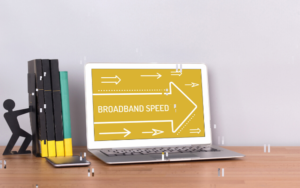 The speed of your broadband greatly affects the service you receive. Most of our homes are connected to the internet because the internet provides us with information, helps connect us to our loved ones and supplies entertainment. Therefore if the speed is too low and the service is poor, your overall enjoyment goes down.
The speed of your broadband greatly affects the service you receive. Most of our homes are connected to the internet because the internet provides us with information, helps connect us to our loved ones and supplies entertainment. Therefore if the speed is too low and the service is poor, your overall enjoyment goes down.
Many people do not realise that they may not receive the download and upload speeds advertised by their internet provider. Below I explain how to check your broadband speed and why it could make a big difference to your service.
What is broadband speed?
Broadband speed is measured in megabits per second (Mbps), which refers to the amount of data (in megabits) that can be sent from or to your device in one second. Your broadband speed can be measured in two main ways:
Speed from the exchange to your property
Also known as your line access speed, this is the maximum speed between your local telephone exchange and your property. The speed and quality of this connection will depend upon how far you live from your exchange, if you receive broadband via a phone line. The speed of a fibre optic broadband connection is not affected by the distance your house is from the telephone exchange.
Speed you experience in your home
Also known as throughput speed, this is the actual speed you experience on your mobile, computer, games console or other device you may have connected to your broadband network. This speed will be lower than the line access speed as it is affected by factors such as the quality of your router, the layout of your property and how many devices are connected to the network.
Why should I check my broadband speed?
According to ASA (Advertising Standards Authority) rules, internet providers must advertise an average speed that at least 50% of their customers receive at the network’s busiest time, which is 8-10pm. That means that up to 50% of customers are not getting the advertised speed. Your provider will also give you a minimum guaranteed line access speed for your broadband service, which may be very different to the advertised speed. The download speed that reaches your device will be affected by the quality of your router, the layout of your home and how many devices are connected to the internet. It can also vary by time of day.
Checking your internet speed can help you make sure you are at least getting the guaranteed download speed, but also how far away you are from the advertised speed you are paying for.
How can I check my broadband speed?
There are a number of tests available on the internet such as the one provided by Uswitch. What is useful with this particular speed test is that it shows how your tested broadband speed compares with that available through other providers. There are also a number of smartphone apps available to test your broadband speed with just one button tap. Once you have tested your broadband speed, check with your provider the guaranteed minimum speed your particular service is meant to provide.
What can I do if my broadband is slower than advertised?
Once you have completed your speed test, compare the results to your guaranteed minimum speed, which should be listed in your contract. If your broadband is slower than the speed you have been promised, contact your provider. Providers that are signed up to Ofcom’s Broadband Speeds Code of Practice – BT, EE, Plusnet, Sky, TalkTalk, Utility Warehouse, Virgin Media and Zen Internet – should take steps to diagnose the problem. If your slow speeds are because of problems within the network, your provider will need to fix it within 30 days. If you are not getting your promised speed within that time frame, you have the right to exit your contract without being penalised.
If you are unsure what speed home broadband your household needs, read our article ‘What broadband speed do I need?’. If you do cancel your broadband, it should be easy to find a new provider and switch your service over. If you need more information, read our article ‘How to switch broadband provider’.




